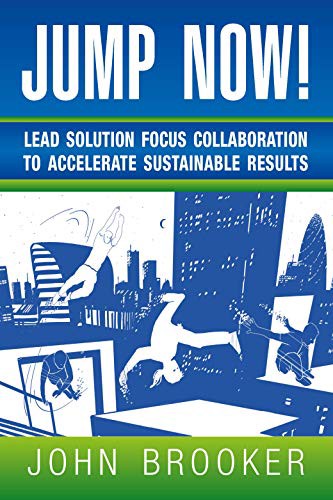"Jump Now!"
Lead Solution Focus collaboration to accelerate sustainable results
Nov 1, 2022

Reviewed by Marika Tammeaid
ColLab is an interaction blending relationship and task
When I learned that John Brooker is writing a new book, I started looking forward to it with confidence and joy. It had already been a while from his last book The Creative Gorilla (2013), and we all had been able to enjoy his fresh, creative, and well-packaged tools in various SF conferences. So, that gave good grounds for anticipating a great book giving food for thought and action for working in SF way with organisations. And I must say, all these expectations were rewarded, and even more.
Jump Now! Lead Solution Focus collaboration to accelerate sustainable results is a full-bodied guide to SF style change process in organisations for both more and less experienced SF practitioners, and in addition those new to SF. It is a challenge to write a good book serving so many different audiences, and John has handled that task very well.
The structure of the book provides different paths to follow for those who seek inspiration to their workshops, to those who want to become better leaders in general and those who seek a framework to follow when tackling a specific challenge with a group.
In addition to providing this variety, John also binds these different aspirations into one by pointing out explicitly that only SF presuppositions and outlook combined to tools and the SF way to ask questions together make the collaborative space where a sustainable change can happen, the CoLab spirit. With this important notion he stays out of the trap of a trick book, which sometimes afflicts SF tool packages.
Exploring SF meta-learning
John uses the metaphor of DNA about the intertwined continuum of focus, question patterns, pace of progress and use of space in a coherent SF change process. Personally, I am not that fond of metaphors rooting to natural sciences, but this an important attempt to describe the characteristic interplay of SF approach for building co-operation, progress, and learning. For me, this metamodel of understanding communications processes is still seeding - in the footsteps of Zeig and Erickson. However, I find it very important that John generates discussion among SF practitioners about different possibilities to describe the meta-learning SF provokes within groups and individuals and hope this discussion gets a sparkle also from this book.
One of the great merits of the book is that a lot of attention is given to the art of asking Solution Focused questions in a creative manner and in the harmony with the organisational context on hand. Focus and effects of different kind of questions are illustrated firstly by the Solution Focused Compass and secondly with a Solution Focus Question Tree, which both I find extraordinarily useful aide-memoire in teaching and learning SF.
In addition to that the book is full of helpful questions, visualisations, activities, alternative activities and even detailed timings – all valuable for the reader’s learning process and accompanied with illustrative real-setting examples. That all makes the book a pleasant read. Describing the change process as a free run or parkour, i.e. moving forward by making best out of the objects and challenges on the way is also a fascinating concept.
New kind of introduction to Solution Focus
Jump Now! is a very practical book and as such a useful companion for all change-makers, more or less acquainted with SF. However, I think it is a treasure also in another way. It serves as a learning guide to SF thinking and action in general and while doing so it creates a fresh way to describe what SF is, what SF does, and what makes SF powerful.
In my experience there is a wide-spread and highly canonised way to teach and describe SF and that way originating from one-to-one therapy sphere does not always suit well in organisational and group settings. That is why it is so uplifting to get alternative descriptions adjacent to context of organisations and the working life. In this respect Jump Now! is a remarkable book.